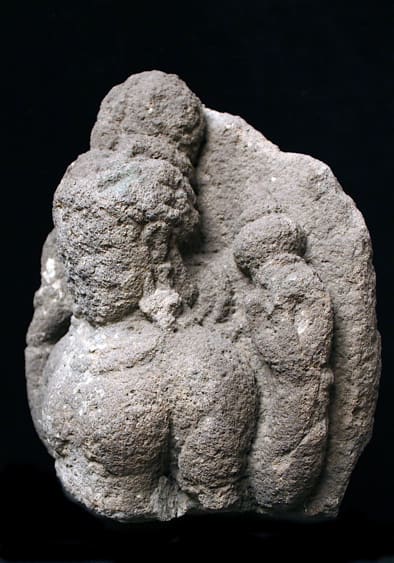Gupta Stone Bust of a Female Deity, 4th Century CE
Stone
12 x 15 x 6.5
DE.022
This imposing stone bust of a multi-armed female deity dates from what many refer to as the Golden Age of India. At this date, what is now northern India, Bangladesh...
This imposing stone bust of a multi-armed female deity dates from what many refer to as the Golden Age of India. At this date, what is now northern India, Bangladesh and parts of Pakistan were ruled by the emperors of the Gupta Empire, whose peaceful and prosperous rule saw a flowering of arts and sciences that ranks alongside the civilisations of the Han and Tang Dynasties and the Roman Empire. The achievements of the Gupta Empire are numerous and impressive. Their stable currency of gold dinars, combined with an effective administrative system, helped to fund major developments in architecture, medicine, art, drama, design, mathematics and literature. The western world learnt much of its expertise in pharmacopoeia, cesarean section, bone setting, and skin grafting from Indian medics of this period. The Indian numeral system – which we use today – was taken by the Arabs to Europe where it replaced the Roman system; seemingly western inventions such as the decimal system, algebra, geometry and astronomy – especially the description of heavenly bodies and their orbits, and the assertion that the earth is round rather than flat – were all either invented or refined in the Gupta period.
The empire’s shadowy beginnings are generally agreed to have started with the reign of Sri- Gupta in around 250 AD, whose people may have come from the Bengal area. By the 4th century there were various small Gupta kingdoms scattered around the Magadha area. The early rulers of the Gupta Empire – and their followers – were firm believers in Hinduism, but were tolerant of other religions and permitted the construction of temples and shrines to the Buddhist faith. Interestingly, the Hindu cults of Saivism and Vaisnavism shared many characteristics of Buddhism, to the extent that Buddha was eventually accepted as an alter-ego of Vishnu.
The empire’s shadowy beginnings are generally agreed to have started with the reign of Sri- Gupta in around 250 AD, whose people may have come from the Bengal area. By the 4th century there were various small Gupta kingdoms scattered around the Magadha area. The early rulers of the Gupta Empire – and their followers – were firm believers in Hinduism, but were tolerant of other religions and permitted the construction of temples and shrines to the Buddhist faith. Interestingly, the Hindu cults of Saivism and Vaisnavism shared many characteristics of Buddhism, to the extent that Buddha was eventually accepted as an alter-ego of Vishnu.
